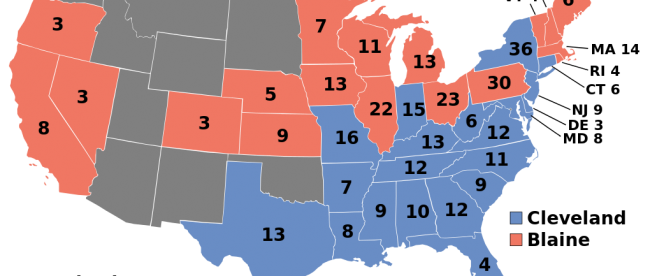Cleveland’s Pole Tax

The Presidency of Grover Cleveland is already unique for the well-known reason that his two terms were not consecutive. Cleveland won the 1884 Presidential election by a narrow margin — less than a half a percent of the popular vote — and took the Presidency. Four years later, Cleveland again won the popular vote — 48.6% to Benjamin Harrison’s 47.8% — but this time, he failed to get a majority of the Electoral College and returned to private life. Cleveland, though, was undaunted; in 1892, he ran again, and for a third straight campaign took a plurality of the popular vote, and once again became President.
But Cleveland came close to not being elected in the first place, due to a scandal surrounding a quirky law and the hiring of a man named George Bennisky.
Cleveland was 24 years old and living in Buffalo, New York, when the Civil War began in April of 1861. About a year into the war, the Confederacy instituted a military draft, and shortly thereafter, the North passed the Militia Act of 1862. The Militia Act allowed states to conscript men in order to meet the state’s military quotas, but it proved unsuccessful — the decentralized nature of the law made it easy for states to shirk their obligations. So in February of 1863, Congress passed a law instituting the United States’ first ever nationally-administered draft. The Enrollment Act, as it was named, went into effect in March of that year, just two weeks before Grover Cleveland’s 26th birthday. And that birthday was significant: the Enrollment Act, per Wikipedia, “required the enrollment of every male citizen and those immigrants who had filed for citizenship between ages twenty and forty-five.”
Like the Militia Act, the Enrollment Act focused on state quotas. If your state had enough volunteer soldiers, there was no threat of being drafted. But if your state was under quota, unlike the Militia Act, it required the state to conscript people into service. New York was one of those under-quota states, and Cleveland, serving as the newly-appointed district attorney in the Buffalo area, was therefore required to enlist if so needed — kind of. The Enrollment Act came with a loophole called “substitution.” If you were called to serve, you could avoid service by hiring someone to fight in your place.
That’s exactly what Cleveland did. For $150 — worth more than $2,000 in today’s dollars — he hired a 32-year-old Polish immigrant named George Bennisky to serve in his place. Not much else is known about Bennisky, except that he survived the war. He suffered an injury early on and was assigned to work at a military hospital for the duration of the conflict. Cleveland, on the other hand, waited out the war as a local lawyer. Subsequently, he would become Mayor of Buffalo, then Governor of New York, and later President of the United States. In an era where literally every other President — from Ulysses S. Grant (18th President, term time began in 1869) to William McKinley (25th, term ended in 1901) — served in the Civil War, Grover Cleveland was alone in being a (legal) draft dodger.
The fact that Cleveland’s political opponents were unable to use his draft avoidance to their benefit (and yes, they tried) probably has a lot to do with the fact that substitution, while controversial, was pretty common at the time. (It also probably helped that most of Cleveland’s presidential support came from the Southern states, who probably weren’t too upset by the fact that the candidate himself didn’t take up arms against them.) Of the roughly 2.1 million Union soldiers in the Civil War, only about 170,000 were conscripted through the Enrollment Act, and of those 170,000, about 120,000 were substitutes.
Bonus Fact: The Enrollment Act was incredibly unpopular in New York City, especially among poor whites, who were subject to the Act (blacks were typically not citizens) but couldn’t afford to hire substitutes. For various reasons, many of these New Yorkers either sympathized with the Confederacy or otherwise wanted the city to remain out of the war. (Check out page 110 of Now I Know, the book, for more.) When the Enrollment Act draft began in July of 1863, it was met with resistance. On the date that the second round of draft numbers were drawn (July 13th), a crowd gathered and riots followed. The New York Draft Riots, as the carnage is now called, lasted a week, as Union soldiers were initially needed elsewhere. Approximately 120 people died and another 2,000 were injured before the violence was quelled.
From the Archives: Candy Barred: The Baby Ruth candy bar is often said to be named after Grover Cleveland’s daughter Ruth. That’s not true. Here’s the real story.
Take the Quiz: A straightforward one: Name the Presidents of the United States.
Related: Gangs of New York, the 2003 Martin Scorsese movie starring Leonardo DiCaprio, Cameron Diaz, John C. Reilly, and some other guy. The New York Draft Riots play a pivotal role in the film (but Grover Cleveland does not). Fun fact: Gangs of New York was nominated for ten Academy Awards but won none — but that’s not a record. The Turning Point and The Color Purple share that odd honor, with 11 nominations apiece but no wins between them.
